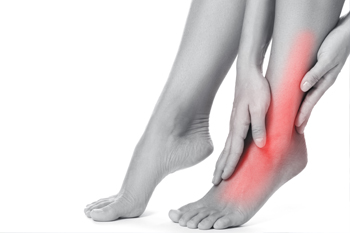Items filtered by date: February 2024
Foot Dystonia

Dystonia is a neurological disorder causing involuntary muscle contractions and repetitive movements. When it affects the feet, it can lead to abnormal postures, twisting, and repetitive movements that affect mobility and balance. Foot dystonia can manifest as toe curling, arch cramping, or uncontrollable foot movements. These symptoms can cause discomfort, pain, and difficulty walking or standing. Additionally, foot dystonia may result in deformities, such as claw toes or high arches, over time. Treatment typically involves a combination of therapies, including medications, injections, and sometimes surgical interventions. If you or your child has unusual symptoms to do with movement of the feet, it is strongly suggested that you schedule an appointment with a podiatrist for an evaluation and diagnosis. Regular monitoring and adjustments to treatment plans may be necessary to address changes in symptoms and optimize outcomes.
Some foot conditions may require additional professional care. If you have any concerns, contact one our of podiatrists of The Foot and Ankle Specialists. Our doctors can provide the care you need to keep you pain-free and on your feet.
Rare Foot Conditions
The majority of foot conditions are common and can be treated by a podiatrist. Standard diagnostic procedures are generally used to identify specific conditions and treatment can be rendered. A podiatrist also treats rare foot conditions which can be difficult to diagnose and may need extra attention and care.
There are many rare foot conditions that can affect children. Some of these can include:
- Freiberg’s disease
- Kohler’s disease
- Maffucci syndrome
Freiberg’s disease - This can be seen as a deterioration and flattening of a metatarsal bone that exists in the ball of the foot. It typically affects pre-teen and teenage girls, but can affect anyone at any age. Symptoms that can accompany this can be swelling, stiffness, and the patient may limp.
Kohler’s disease - This often targets the bone in the arch of the foot and affects younger boys. It can lead to an interruption of the blood supply which ultimately can lead to bone deterioration. The patient may limp or experience tenderness, swelling, and redness.
Maffucci syndrome - This affects the long bones in a child’s foot leading to the development of abnormal bone lesions. They are benign growths and typically develop in early childhood and the bones may be susceptible to breaking.
A podiatrist can properly diagnose and treat all types of rare foot conditions. If your child is affected by any of these symptoms or conditions, please don’t hesitate to call our office so the correct treatment method can begin.
If you have any questions please feel free to contact our offices located in Houston, Deer Park, and Mont Belvieu, TX . We offer the newest diagnostic tools and technology to treat your foot and ankle needs.
Get Professional Care for a Broken Foot or Ankle
Two Types of Hammertoe and Their Treatments
 Hammertoe is a common deformity in which the second, third, or fourth toe is bent at the middle joint. Hammertoes can either be flexible or rigid. Flexible hammertoe is a milder deformity where the affected toe can still be straightened manually, especially when not bearing weight. This type of hammertoe may cause some discomfort, but tends to be more responsive to conservative treatments, such as wearing roomier footwear or using toe cushions. Rigid hammertoe is a more severe form of the condition. This type of hammertoe is stuck in a bent position and cannot be straightened manually. Rigid hammertoe may result in chronic pain, and corns or calluses may develop due to increased pressure and friction against shoes. Podiatrists may use more aggressive treatments, like splinting or surgical intervention, to align the toe properly and alleviate symptoms of rigid hammertoe. If you have a hammertoe, or you are experiencing pain due to this condition, it is suggested that you schedule an appointment with a podiatrist who can provide you with treatment options that are right for you.
Hammertoe is a common deformity in which the second, third, or fourth toe is bent at the middle joint. Hammertoes can either be flexible or rigid. Flexible hammertoe is a milder deformity where the affected toe can still be straightened manually, especially when not bearing weight. This type of hammertoe may cause some discomfort, but tends to be more responsive to conservative treatments, such as wearing roomier footwear or using toe cushions. Rigid hammertoe is a more severe form of the condition. This type of hammertoe is stuck in a bent position and cannot be straightened manually. Rigid hammertoe may result in chronic pain, and corns or calluses may develop due to increased pressure and friction against shoes. Podiatrists may use more aggressive treatments, like splinting or surgical intervention, to align the toe properly and alleviate symptoms of rigid hammertoe. If you have a hammertoe, or you are experiencing pain due to this condition, it is suggested that you schedule an appointment with a podiatrist who can provide you with treatment options that are right for you.
Hammertoe
Hammertoes can be a painful condition to live with. For more information, contact one our of podiatrists from The Foot and Ankle Specialists. Our doctors will answer any of your foot- and ankle-related questions.
Hammertoe is a foot deformity that affects the joints of the second, third, fourth, or fifth toes of your feet. It is a painful foot condition in which these toes curl and arch up, which can often lead to pain when wearing footwear.
Symptoms
- Pain in the affected toes
- Development of corns or calluses due to friction
- Inflammation
- Redness
- Contracture of the toes
Causes
Genetics – People who are genetically predisposed to hammertoe are often more susceptible
Arthritis – Because arthritis affects the joints in your toes, further deformities stemming from arthritis can occur
Trauma – Direct trauma to the toes could potentially lead to hammertoe
Ill-fitting shoes – Undue pressure on the front of the toes from ill-fitting shoes can potentially lead to the development of hammertoe
Treatment
Orthotics – Custom made inserts can be used to help relieve pressure placed on the toes and therefore relieve some of the pain associated with it
Medications – Oral medications such as anti-inflammatories or NSAIDs could be used to treat the pain and inflammation hammertoes causes. Injections of corticosteroids are also sometimes used
Surgery – In more severe cases where the hammertoes have become more rigid, foot surgery is a potential option
If you have any questions please contact our offices located in Houston, Deer Park, and Mont Belvieu, TX . We offer the newest diagnostic and treatment technologies for all your foot and ankle needs.
Burning Foot Pain May Signal Morton’s Neuroma

If you've been experiencing a burning sensation in your feet that extends into your toes, it could be a sign of Morton's neuroma. This is a condition characterized by a fibrous enlargement of the plantar nerve in the forefoot, most commonly the area between your third and fourth toes. It is often caused by compression from tight shoes, and women who wear high heels are particularly susceptible to Morton’s neuroma. The compression from footwear leads to inflammation and discomfort, which is made worse during activities like running or walking. A podiatrist can conduct an examination of your feet to determine whether you have Morton’s neuroma. Diagnosis typically involves ultrasound imaging to locate the neuroma, followed by cortisone injections to reduce inflammation, with surgery reserved for severe cases due to the risk of complications. With proper treatment, you can find relief from the discomfort and get back to enjoying your activities. If you believe you may have Morton’s neuroma, it is suggested that you make an appointment with a podiatrist.
Morton’s neuroma is a very uncomfortable condition to live with. If you think you have Morton’s neuroma, contact one our of podiatrists of The Foot and Ankle Specialists. Our doctors will attend to all of your foot care needs and answer any of your related questions.
Morton’s Neuroma
Morton's neuroma is a painful foot condition that commonly affects the areas between the second and third or third and fourth toe, although other areas of the foot are also susceptible. Morton’s neuroma is caused by an inflamed nerve in the foot that is being squeezed and aggravated by surrounding bones.
What Increases the Chances of Having Morton’s Neuroma?
- Ill-fitting high heels or shoes that add pressure to the toe or foot
- Jogging, running or any sport that involves constant impact to the foot
- Flat feet, bunions, and any other foot deformities
Morton’s neuroma is a very treatable condition. Orthotics and shoe inserts can often be used to alleviate the pain on the forefront of the feet. In more severe cases, corticosteroids can also be prescribed. In order to figure out the best treatment for your neuroma, it’s recommended to seek the care of a podiatrist who can diagnose your condition and provide different treatment options.
If you have any questions, please feel free to contact our offices located in Houston, Deer Park, and Mont Belvieu, TX . We offer the newest diagnostic and treatment technologies for all your foot care needs.
Types and Grades of Ankle Sprains

Ankle sprains, a common injury affecting individuals regardless of activity level, can take various forms. Inversion ankle sprains, the most prevalent type, occur when the foot abruptly turns inward, stretching the outer ligaments. This type of ankle sprain is commonly experienced during activities like running or basketball. Eversion ankle sprains, which are less frequent but equally painful, result from the foot rolling outward, affecting inner ligaments, often seen in gymnastics. Understanding the grades of ankle sprains further aids in treatment decisions. Grade 1 sprains involve mild symptoms and minimal ligament damage, allowing for continued activity with caution. Grade 2 sprains, moderate in severity, entail partial ligament tears. This leads to more pronounced swelling and discomfort, potentially requiring more extensive treatment. Grade 3 sprains, the most severe, feature complete ligament tears, or ruptures, resulting in significant pain, instability, and necessitating thorough rehabilitation for full recovery. Whether you are an athlete or a casual walker, it is suggested that you consult a podiatrist if you have incurred an ankle sprain to ensure a smoother return to daily activities with proper care and attention.
Ankle sprains are common but need immediate attention. If you need your feet checked, contact one our of podiatrists from The Foot and Ankle Specialists. Our doctors can provide the care you need to keep you pain-free and on your feet.
How Does an Ankle Sprain Occur?
Ankle sprains take place when the ligaments in your ankle are torn or stretched beyond their limits. There are multiple ways that the ankle can become injured, including twisting or rolling over onto your ankle, putting undue stress on it, or causing trauma to the ankle itself.
What Are the Symptoms?
- Mild to moderate bruising
- Limited mobility
- Swelling
- Discoloration of the skin (depending on severity)
Preventing a Sprain
- Wearing appropriate shoes for the occasion
- Stretching before exercises and sports
- Knowing your limits
Treatment of a Sprain
Treatment of a sprain depends on the severity. Many times, people are told to rest and remain off their feet completely, while others are given an air cast. If the sprain is very severe, surgery may be required.
If you have suffered an ankle sprain previously, you may want to consider additional support such as a brace and regular exercises to strengthen the ankle.
If you have any questions please feel free to contact our offices located in Houston, Deer Park, and Mont Belvieu, TX . We offer the newest diagnostic and treatment technologies for all your foot and ankle needs.

